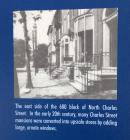Inscription
Mount Vernon Cultural Walk
Contrary to Baltimore's 19th century conservative appearance, Baltimoreans created progressive, diverse communities that expanded the nation's racial and religious freedom. By the time of the Civil War, Baltimore had the largest free African American population in the country; approximately 28,000 African Americans lived in Baltimore and 26,000 were free.Some of the most affluent African American, many of whom owned their own homes, lived on Hamilton Street, just east of Charles Street: William Bishop, barber; Emory Bond, confectioner; Alexander Wayman, bishop of the Bethel AME Church; Nicholas Dutton, carter; and Romeo Price, waiter. By 1860, Baltimore had more than 1,300 African American property owners and 44 African American institutions, including 16 churches and 15 schools. Baltimore contained one of the diverse and successful African American communities in the country.
Baltimoreans formed the first American Roman Catholic diocese; built the first Swedenborgian Church structure in America; gave birth to the Methodist Episcopal Church and the Church of the United Brethren; co-founded the African Methodist Episcopal Church; and hosted the first sermon pronouncing the Unitarian doctrine. These movements, in which Baltimore was central, proliferated and influenced communities throughout the country.
Standing on this corner, the First Unitarian Church, American's oldest continuously used Unitarian Church, represents one of the nation's greatest "Neo-classical" buildings. The simple, geometric design, constructed in 1818, portrays the desire of the congregation to create a church "modeled upon the simple principles of the Gospels." It was designed by Maximilian Godefroy (ca. 1770-1837), who was classically educated in France and exiled to America for his opposition to the Napoleonic regime.
Details
| HM Number | HM1XHJ |
|---|---|
| Tags | |
| Historical Period | 19th Century |
| Historical Place | Town |
| Marker Type | Historic District |
| Marker Class | Historical Marker |
| Marker Style | Free Standing |
| Marker Condition | No reports yet |
| Date Added | Saturday, March 25th, 2017 at 7:09pm PDT -07:00 |
Pictures
Photo Credits: [1] SEPTEMBERSPARROW1666 [2] SEPTEMBERSPARROW1666 [3] SEPTEMBERSPARROW1666 [4] SEPTEMBERSPARROW1666 [5] SEPTEMBERSPARROW1666 [6] SEPTEMBERSPARROW1666 [7] SEPTEMBERSPARROW1666 [8] SEPTEMBERSPARROW1666 [9] SEPTEMBERSPARROW1666
Locationbig map
| UTM (WGS84 Datum) | 18S E 360677 N 4350819 |
|---|---|
| Decimal Degrees | 39.29555500, -76.61565306 |
| Degrees and Decimal Minutes | N 39° 17.7333', W 76° 36.9392' |
| Degrees, Minutes and Seconds | 39° 17' 43.9980" N, 76° 36' 56.3510" W |
| Driving Directions | Google Maps |
| Area Code(s) | 410, 443, 301 |
| Can be seen from road? | Yes |
| Is marker in the median? | No |
| Which side of the road? | Marker is on the right when traveling South |
| Closest Postal Address | At or near 12 W Franklin St, Baltimore MD 21201, US |
| Alternative Maps | Google Maps, MapQuest, Bing Maps, Yahoo Maps, MSR Maps, OpenCycleMap, MyTopo Maps, OpenStreetMap |
Is this marker missing? Are the coordinates wrong? Do you have additional information that you would like to share with us? If so, check in.
Nearby Markersshow on map
Exercising Freedom: Overcoming Racial and Religious Boundaries Historical
The First Unitarian Church of Baltimore
The First Unitarian Church of Baltimore
First Unitarian Church
Pope John Paul II Monument Historical
Walters Art Museum
Expanding the American Intellect: Icons and Iconoclasts
Freedom & Equality for All
Memorial To Edward Berge
George Washington Bicentennial Marker
Maintenance Issues
- Is this marker part of a series?
- Who or what organization placed the marker?









Comments 0 comments